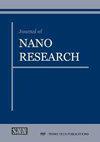The Effect of Surface Treatment/Polymer Type on Formation of 3D-Boron Nitride Foams
IF 1
4区 材料科学
Q4 MATERIALS SCIENCE, MULTIDISCIPLINARY
引用次数: 0
Abstract
In this study, the use of boron nitride (BN) foam composites as adsorbents in wastewater treatment using polyvinyl alcohol (PVA), polyvinyl butyral (PVB) and polyester (PE) polymers has been investigated. BN powder has been functionalized by Hummer’s and sodium hydroxide (NaOH) methods to facilitate BN binding with the polymer. Fourier Transform Infrared (FT-IR) results show that hydroxyl (-OH) groups are effectively bounded to the BN structure. Scanning Electron Microscope (SEM) observation demonstrated the 3D interconnected porous structure of the obtained BN foams using different polymers. It is observed that BN and polymer interaction is better in foams formed with PVA and PVB compared to PE polymers. PVA and PVB structure shows a bridge property to link the layers so that a porous network structure is formed. It has been determined that the foam composite modified with Hummer’s method and using PVB as a polymer (h-BN-PVB-H) reaches an adsorption capacity of 8.843 mg/g in 44 hours and provides approximately 18% Crystal Violet (CV) dye removal. h-BN-PVB-H foam composite removes approximately 26% of Reactive Blue 49 (RB 49) dye with an adsorption capacity of 12.313 mg/g in the first 10 minutes. The 3D BN/Polymer foams showed reasonable absorption capacities for olive oil, cyclohexane and toluene from 200-980 wt% relative to the foam’s dry weight. It shows that the produced composite foams can absorb approximately 2-10 times their own weight.表面处理/聚合物类型对三维氮化硼泡沫形成的影响
研究了氮化硼(BN)泡沫复合材料在聚乙烯醇(PVA)、聚乙烯醇丁醛(PVB)和聚酯(PE)聚合物废水处理中的吸附作用。采用Hummer法和氢氧化钠(NaOH)法对氮化硼粉体进行功能化处理,以促进氮化硼与聚合物的结合。傅里叶变换红外(FT-IR)结果表明,羟基(-OH)基团与BN结构有效结合。扫描电镜(SEM)观察了不同聚合物制备的BN泡沫的三维互联多孔结构。与PE聚合物相比,PVA和PVB形成的泡沫中BN与聚合物的相互作用更好。PVA和PVB结构表现出桥接性质,连接各层,从而形成多孔网络结构。经测定,以PVB为聚合物,采用Hummer方法改性的泡沫复合材料(h-BN-PVB-H)在44小时内的吸附量为8.843 mg/g,可脱除约18%的结晶紫(CV)染料。h-BN-PVB-H泡沫复合材料在前10分钟内去除活性蓝49 (RB 49)染料约26%,吸附量为12.313 mg/g。三维BN/聚合物泡沫对橄榄油、环己烷和甲苯的吸附能力相对于泡沫的干重在200-980 wt%之间。结果表明,所制备的复合泡沫材料的吸收率约为其自重的2-10倍。
本文章由计算机程序翻译,如有差异,请以英文原文为准。
求助全文
约1分钟内获得全文
求助全文
来源期刊

Journal of Nano Research
工程技术-材料科学:综合
CiteScore
2.40
自引率
5.90%
发文量
55
审稿时长
4 months
期刊介绍:
"Journal of Nano Research" (JNanoR) is a multidisciplinary journal, which publishes high quality scientific and engineering papers on all aspects of research in the area of nanoscience and nanotechnologies and wide practical application of achieved results.
"Journal of Nano Research" is one of the largest periodicals in the field of nanoscience and nanotechnologies. All papers are peer-reviewed and edited.
Authors retain the right to publish an extended and significantly updated version in another periodical.
 求助内容:
求助内容: 应助结果提醒方式:
应助结果提醒方式:


